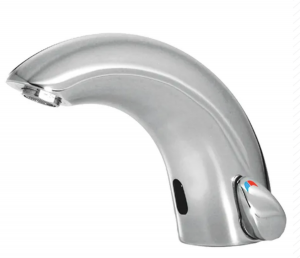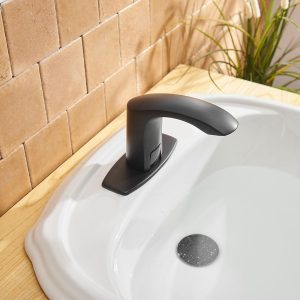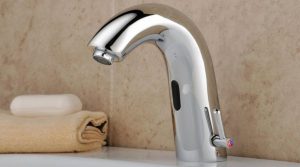Touchless Bathroom Faucets: Innovating Hygiene and Convenience
In recent years, touchless bathroom faucets have become more than just a trend; they represent a transformative leap in bathroom technology. With the incorporation of motion sensors and infrared technology, these faucets have taken center stage in homes and public spaces alike. In this article, we will delve into the world of touchless bathroom faucets, exploring their benefits, the technology behind them, their design aesthetics, and the role of the renowned brand iVIGA in shaping this innovative market.
Touchless bathroom faucets have revolutionized the way we interact with our bathroom fixtures. With the wave of a hand or a gentle touch, these innovative faucets provide a hygienic and efficient water flow, enhancing the overall bathroom experience. Let’s delve into the world of best touchless bathroom faucets.
The Evolution of Best Touchless Bathroom Faucets
The concept of touchless faucets originated in commercial spaces and public restrooms, primarily for hygiene purposes. However, their adoption in residential bathrooms has grown significantly, driven by the realization that they offer far more advantages than just reducing the spread of germs.
Enhanced Hygiene and Health
One of the foremost reasons for the widespread adoption of touchless bathroom faucets is their contribution to enhanced hygiene. Traditional faucets necessitate physical contact with handles or knobs, which can serve as breeding grounds for harmful bacteria and viruses. Touchless faucets eliminate this risk, thereby reducing the chance of cross-contamination and promoting better health. Touchless faucets minimize the spread of germs and bacteria, as users don’t need to touch the handles with dirty hands. This feature is especially beneficial in public restrooms and households with young children.
Water Conservation
Touchless faucets come equipped with sensors that accurately measure the required amount of water for a given task. This technology facilitates optimal water conservation, as the faucet only activates when a user’s presence is detected. This reduction in water wastage benefits not only the environment but also your utility bills. Most touchless faucets are equipped with sensors that control water flow. They automatically turn off when not in use, preventing water wastage and contributing to eco-friendliness.

Convenience and Accessibility
Beyond hygiene and water conservation, touchless bathroom faucets offer unparalleled convenience. They prove particularly useful when your hands are dirty or otherwise occupied, such as during food preparation or other messy tasks. Moreover, these faucets enhance accessibility, making them invaluable in inclusive bathroom design for individuals with mobility challenges or disabilities. The hands-free operation is not only hygienic but also incredibly convenient. It’s ideal for tasks like teeth brushing or washing your face when you don’t want to touch the faucet with wet hands.
The Technology Behind Touchless Faucets
Understanding the technology that drives touchless bathroom faucets is crucial to grasp their capabilities fully. Most touchless faucets rely on one of two sensor technologies:
- Infrared Sensors: Infrared sensors utilize infrared light to detect the presence of an object, typically a user’s hands. When motion is detected, the sensor activates the faucet to release water. This technology is highly responsive and widely used in touchless faucets.
- Capacitive Sensors: Capacitive sensors rely on changes in electrical capacitance to detect nearby objects. When a user’s hand approaches the sensor area, it disrupts the electrical field, triggering the faucet. Capacitive sensors are renowned for their reliability and precision.
Design and Aesthetics
Touchless bathroom faucets are designed to harmoniously blend into modern bathroom aesthetics. They are available in a wide range of styles, finishes, and shapes, ensuring that homeowners can select fixtures that complement their design preferences. Whether you prefer a sleek, minimalist appearance or a more traditional design, touchless faucets offer diverse choices.
Installation and Compatibility
Installing a touchless bathroom faucet is typically a straightforward process, whether you are retrofitting an existing sink or incorporating it into a new bathroom design. Many touchless faucets are compatible with standard sink configurations, making the transition to touchless technology relatively effortless.
The iVIGA Touchless Faucet Collection
In the realm of touchless bathroom faucets, iVIGA is a name synonymous with innovation, quality, and user satisfaction. Let’s explore how iVIGA has left its indelible mark on this transformative market.
- iVIGA’s Commitment to Quality: iVIGA’s touchless faucets are crafted with meticulous attention to detail and the finest materials, ensuring they stand the test of time. The brand’s dedication to quality extends throughout its product range.
- Innovation at the Core: iVIGA has always been at the forefront of faucet technology. Their bathroom faucets feature advanced sensors, allowing for seamless and precise water flow control. This innovation enhances the user experience.
- Design Elegance: iVIGA’s touchless faucet designs are a perfect blend of aesthetics and functionality. They offer a range of styles and finishes, allowing homeowners to customize their bathrooms while enjoying the convenience of touchless technology.
- Eco-Consciousness: Sustainability is a key focus for iVIGA. Their touchless faucets are equipped with water-saving technology, contributing to reduced water consumption and a greener environment.

Maintenance and Care
Maintaining a touchless bathroom faucet is relatively simple. Regular cleaning with mild soap and water is usually sufficient to keep the fixture looking pristine. Additionally, it is essential to replace the batteries or recharge the faucet’s power source as needed to ensure consistent performance.
The Future of Touchless Faucets
The future of touchless bathroom faucets holds great promise, with ongoing advancements in sensor technology, water conservation, and design aesthetics. As smart home integration becomes more prevalent, touchless faucets are poised to play a pivotal role in connected bathroom ecosystems. This will enable users to control water flow and temperature via smartphones or voice commands, further enhancing the user experience.
Conclusion
Touchless bathroom faucets have evolved from a hygiene solution into symbols of modern convenience and eco-consciousness. They offer numerous benefits, from reducing the risk of germ transmission to conserving water and enhancing accessibility. As technology continues to evolve, touchless faucets are set to remain at the forefront of bathroom innovation, contributing to healthier, more efficient, and more stylish bathroom spaces in our homes. Whether you’re renovating your bathroom or seeking ways to upgrade your daily routines, an iVIGA touchless bathroom faucet can make a significant difference in your life, offering the perfect fusion of technology and design.
 iVIGA Faucet Online Shop
iVIGA Faucet Online Shop

